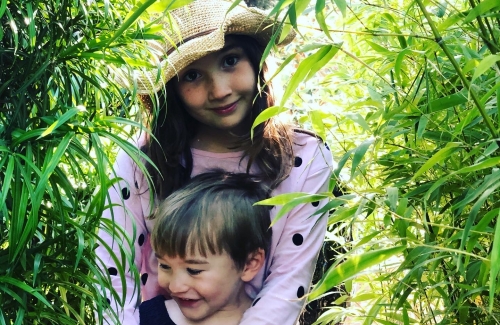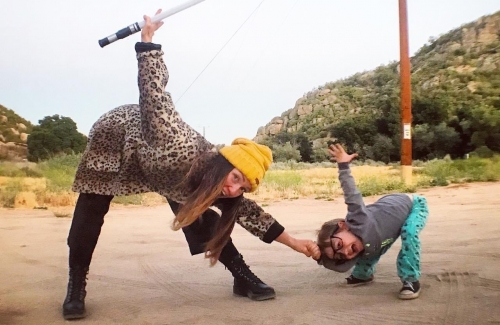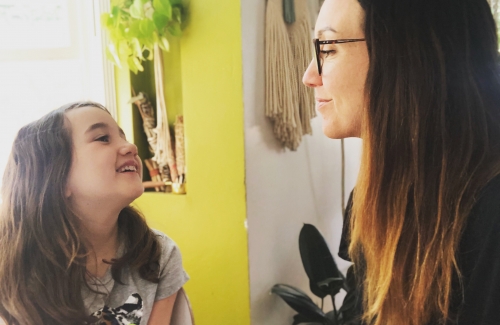Parenting with Levity: How to Gamify Empathy Lessons

This blog post is adapted from a presentation by Marie McDonald, Galileo’s VP of Communications & Southern California Operations. You can watch the full video here or check out the related posts for more on raising empathetic kids.
—
I have a confession to make: I mostly parent through humor. I didn’t read to do that in any book; it’s just how we do it in my fam.
Humor is my natural state and my go-to tool for most sticky kid situations. I find that many power struggles, grumpy moods, and attempts at toddler-style manipulation can be turned around quickly if I approach them with levity. My kids seem to learn that those tactics don’t work, and I’m a much more authentic mama when I’m guiding through play instead of constantly correcting behavior. While it’s definitely not appropriate to lean into the laughs in every situation, humor seems to make many things easier, so I gamify as much as I can.
When my three-year-old is making a grumpy face that’s not so much an expression of a real internal state as it is a blatant tool to get what he wants, mama don’t play. I turn my honest amusement at the face he’s making into a game to make him laugh. When my kids aren’t ready to leave the park, I turn it into a desert of sand that we have to get out of to get to the oasis of the car. It may sound like this takes more energy, but in my experience, it’s actually much easier to be a channel, not a dam by gamifying. And when it’s time to learn about empathy, I’ll gamify that too.
There are times when learning empathy will be necessarily heavy. For the rest of the time, here are some ideas for how to make it fun.
Practice on a project
Choose a family project, and do these things to build empathy skills as you work on it. For example, let’s say you’re interested in building a treehouse in the yard.
Build on the ideas of others.
Collaboration is a necessary skill in the world our kids are inheriting. They’ll need to be able to let go of their ideas in favor of better ones, and they’ll need to build on the thoughts that others throw out. In our treehouse example, that might sound like:
- Your brother thought we could do two levels in the treehouse. How could you imagine that working?
- The bright blue paint color you like isn’t the rest of the family’s favorite choice. What do you think about some of these other options that we like?
Design for the interests and needs of others.
Thinking about what different people who use it might want or need out of the design in order to be comfortable. That might sound like:
- I know Grandpa wants to read to you in the treehouse. How can we make a seat that will be comfortable for him to use?
- I know you thought of installing a climbing wall on one side of our treehouse, but I’m not sure that will be safe for your younger cousins that share our yard sometimes. What do you think about a slide instead?
Redesign and build empathy with mistakes.
When things don’t go right, we can teach kids how to fail forward by modeling as they watch us respond. That might sound like:
- I mismeasured just about every cut on that wall. Well, that didn’t work out at ALL as we planned. Now we know what doesn’t work, so we can figure out what does. What did we learn about measuring and marking our boards, so we don’t make the same mistake again?
What is it like to be you?
Imagine someone else’s day.
Choose a loved one who lives in a different part of the world or has a different lifestyle, then take that person’s perspective. For younger kids, this might be an imaginative role-playing game, while older kids might prefer to describe and discuss. Help kids take that person’s perspective by asking questions about what they might think or feel.
- When they wake up in the morning, what might their bodies or the weather feel like?
- If the person goes to work, what’s it like for them to get ready for their day?
- If the person is retired, how might they plan their day?
- What’s it like to be really busy, or to miss family?
Take a walk in their shoes.
No, literally. That conversation about what it’s like for someone else can turn into a physical game. As kids walk around in a pair of someone else’s shoes, ask them to imagine what life is like in that person’s body and life. For example:
- How tall are they? What does the world look like from a different perspective?
- What language do they speak? What is it like to speak that language? Do the people around them speak or understand their words? What is that like?
- What type of work or activities do they do? Is it tiring, hard, exciting, or interesting?
Give gifts thoughtfully
When there’s a gift-giving occasion on the horizon, generate ideas together. You might ask some of these questions to get started:
- When have we seen this person that we love the happiest?
- What were they doing when they looked so happy?
- What do they like the very most: colors, animals, objects
- How do they most like to experience the world: through food, music, books, experience new things, or being with others?
Once you decide together, don’t forget to wrap, decorate, and give together too! Kid drawings are the best wrapping paper.
Learn through asking
Help kids learn about others through conducting an interview. First, choose a person and invite them, and then give your kids whatever support they might need to conduct an interview over the phone, a virtual meeting space, or in person. Here are some ideas for questions:
- Tell me about an experience in your life that helped you to grow. What was hardest about it? What did you learn? What were you like before and after?
- Tell me about the moments in life that brought you the most happiness.
- Tell me about one thing you are proudest of.
- Tell me about one thing you dream about doing in the future.
When the interview’s done, it’s time to reflect on what they learned. This is the most important part! Help kids unpack their experience by asking:
- What did we learn about this person that surprised you?
- What are the differences between this person and you? What do you see that is similar?
- What do you appreciate most about them?
Play the strengths game
This one is one of my favorites. We mostly play this game inside our nuclear family unit, and we sometimes direct this game out at the world. This can be done anytime, anywhere and it teaches empathy through spending time with our attention fully focused on someone else.
Choose a person to focus on and think about all of your favorite things about them. For example:
- What is so unique and special about that person?
- What are their strengths/superpowers?
- How can we share what we see with them? (A card, a phone call, etc.)
This exercise is a positive mindset training by teaching us to look for what we like and to share those observations with the people and the world around us.
We can make most of the teaching and learning that we do at home with our kids fun by being a channel for their energy instead of a dam—and enjoy this process of raising the next generation of world evolving changemakers a little bit more while we’re at it. The need for empathy shows up inside and outside of our family units every day. Let’s meet that need together.
—
Sarah McDonald is Galileo’s VP of Southern California Operations. When she’s not heading up camp operations, Sarah loves to write, paint, and adventure with her fam.

 Building a Case for Empathy
Building a Case for Empathy  I Hear You: How to Model Empathy at Home
I Hear You: How to Model Empathy at Home  I See You: 6 Ways to Teach Kids Empathy
I See You: 6 Ways to Teach Kids Empathy 